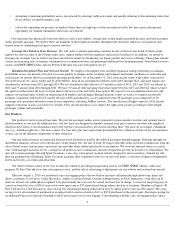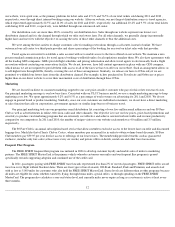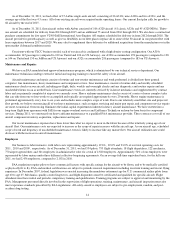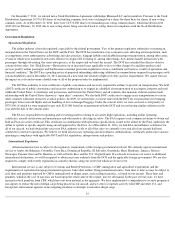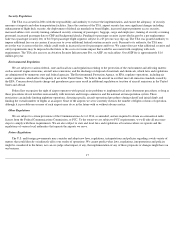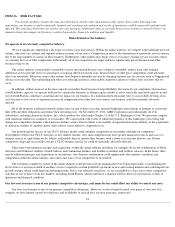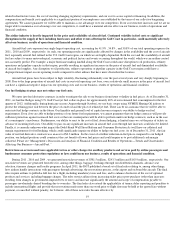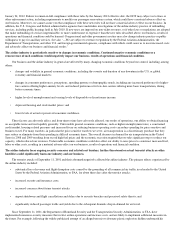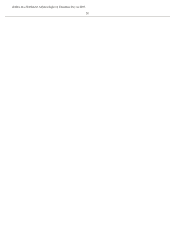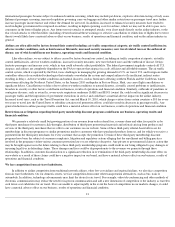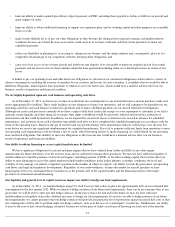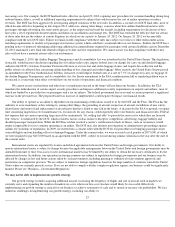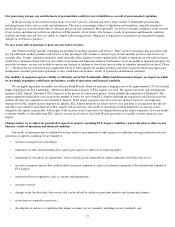Spirit Airlines 2011 Annual Report Download - page 22
Download and view the complete annual report
Please find page 22 of the 2011 Spirit Airlines annual report below. You can navigate through the pages in the report by either clicking on the pages listed below, or by using the keyword search tool below to find specific information within the annual report.
related infrastructure taxes, the cost of meeting changing regulatory requirements, and our cost to access capital or financing. In addition, the
compensation and benefit costs applicable to a significant portion of our employees are established by the terms of our collective bargaining
agreements. We cannot guarantee we will be able to maintain a cost advantage over our competitors. If our cost structure increases and we are no
longer able to maintain a cost advantage over our competitors, it could have a material adverse effect on our business, results of operations and
financial condition.
The airline industry is heavily impacted by the price and availability of aircraft fuel. Continued volatility in fuel costs or significant
disruptions in the supply of fuel, including hurricanes and other events affecting the Gulf Coast in particular, could materially adversely
affect our business, results of operations and financial condition.
Aircraft fuel costs represent our single largest operating cost, accounting for 41.9% , 34.8% , and 30.8%
of our total operating expenses for
2011 , 2010 and 2009
, respectively. As such, our operating results are significantly affected by changes in the availability and the cost of aircraft
fuel, especially aircraft fuel refined in the U.S. Gulf Coast region, on which we are highly dependent. Both the cost and the availability of aircraft
fuel are subject to many meteorological, economic and political factors and events occurring throughout the world, which we can neither control
nor accurately predict. For example, a major hurricane making landfall along the Gulf Coast could cause disruption to oil production, refinery
operations and pipeline capacity in that region, possibly resulting in significant increases in the price of aircraft fuel and diminished availability
of aircraft fuel supplies. Any disruption to oil production, refinery operations or pipeline capacity in the Gulf Coast region could have a
disproportionate impact on our operating results compared to other airlines that have more diversified fuel sources.
Aircraft fuel prices have been subject to high volatility, fluctuating substantially over the past several years and very sharply beginning in
2008. Due to the large proportion of aircraft fuel costs in our total operating cost base, even a relatively small increase in the price of aircraft fuel
can have a significant negative impact on our operating costs and on our business, results of operations and financial condition.
Our fuel hedging strategy may not reduce our fuel costs.
We enter into fuel derivative contracts in order to mitigate the risk to our business from future volatility in fuel prices. As of December 31,
2011, we had fuel hedges using U.S. Gulf Coast jet fuel collars in place for approximately 40% of our estimated fuel consumption for the first
quarter of 2012. Additionally, during hurricane season (August through October), we use basis swaps using NYMEX Heating Oil indexes to
protect the refining price risk between the price of crude oil and the price of refined jet fuel. There can be no assurance that we will be able to
enter into fuel hedge contracts in the future. Our liquidity and general level of capital resources impacts our ability to hedge our fuel
requirements. Even if we are able to hedge portions of our future fuel requirements, we cannot guarantee that our hedge contracts will provide
sufficient protection against increased fuel costs or that our counterparties will be able to perform under our hedge contracts, such as in the case
of a counterparty’s insolvency. Furthermore, our ability to react to the cost of fuel, absent hedging, is limited since we set the price of tickets in
advance of incurring fuel costs. Our ability to pass on any significant increases in aircraft fuel costs through fare increases could also be limited.
Finally, it is currently unknown what impact the Dodd-Frank Wall Street Reform and Consumer Protection Act will have on collateral and
margin requirements for fuel hedging, which could significantly impair our ability to hedge our fuel costs. As of December 31, 2011 , the fair
value of our fuel derivative contracts was an asset of $0.3 million . In the event of a further reduction in fuel prices compared to our hedged
position, our hedged positions could counteract the cost benefit of lower fuel prices and could require us to post additional cash margin
collateral. Please see “Management’s Discussion and Analysis of Financial Condition and Results of Operations—Trends and Uncertainties
Affecting Our Business—Aircraft Fuel.”
Restrictions on or increased taxes applicable to fees or other charges for ancillary products and services paid by airline passengers and
burdensome consumer protection regulations or laws could harm our business, results of operations and financial condition.
During 2011 , 2010 and 2009 , we generated non-ticket revenues of $381.5 million , $243.3 million and $163.9 million , respectively. Our
non-ticket revenues are generated from fees for, among other things, baggage, bookings through our distribution channels, advance seat
selection, itinerary changes and loyalty programs. In April 2011, the DOT published a broad set of final rules relating to, among other things,
how airlines handle interactions with passengers through advertising, the reservations process, at the airport and on board the aircraft. The final
rules require airlines to publish a full fare for a flight, including mandatory taxes and fees, and to enhance disclosure of the cost of optional
products and services, including baggage charges. The rules restrict airlines from increasing ticket prices post-purchase (other than increases
resulting from changes in government-imposed fees or taxes) and increase significantly the amount and scope of compensation payable to
passengers involuntarily denied boarding due to oversales. The final rules also extend the applicability of tarmac delay reporting and penalties to
include international flights and provide that reservations made more than one week prior to flight date may be held at the quoted fare without
payment, or cancelled without penalty, for 24 hours. All of these new rules became effective by
19


